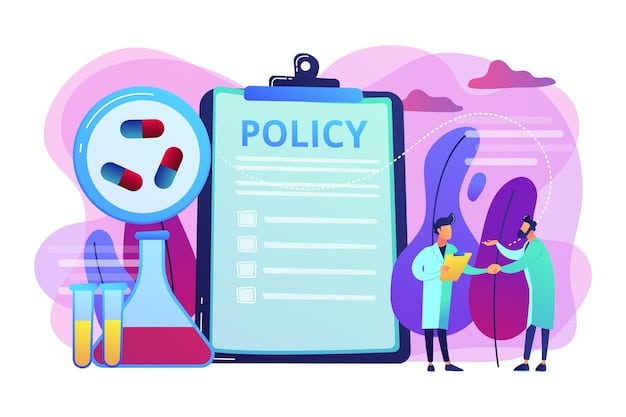Health Savings Accounts (HSAs): Maximize Your Savings in 2025

Health Savings Accounts (HSAs) offer a triple tax advantage, allowing tax-deductible contributions, tax-free growth, and tax-free withdrawals for qualified medical expenses, making them a powerful tool for healthcare savings in 2025 and beyond for eligible individuals.
Planning for healthcare expenses is crucial, and Health Savings Accounts (HSAs): Triple Tax Advantage for Healthcare Savings in 2025 are a powerful tool to help you do just that. An HSA offers a unique approach to saving for medical costs, providing tax advantages that can significantly boost your financial well-being.
Understanding Health Savings Accounts (HSAs)
A Health Savings Account (HSA) is a tax-advantaged savings account that can be used to pay for qualified medical expenses. It’s available to individuals who are enrolled in a high-deductible health plan (HDHP). Understanding the basics of HSAs is key to unlocking their full potential.
Eligibility for HSAs
To be eligible for an HSA, you must meet certain requirements. Primarily, you need to be enrolled in a high-deductible health plan. Let’s delve into the specifics of these eligibility criteria:
- You must have a qualifying high-deductible health plan (HDHP).
- You cannot be enrolled in Medicare.
- You cannot be claimed as a dependent on someone else’s tax return.
- You cannot have other health coverage that is not an HDHP (with some exceptions for specific types of coverage).

Key Features of HSAs
HSAs come with several distinctive features that set them apart from other savings accounts. These features make them particularly attractive for long-term healthcare savings. Here are some key highlights:
- Tax-deductible contributions: Contributions to an HSA are tax-deductible, reducing your taxable income.
- Tax-free growth: The money in your HSA grows tax-free, allowing your savings to accumulate without being taxed annually.
- Tax-free withdrawals: Withdrawals for qualified medical expenses are tax-free, providing a valuable source of funds for healthcare needs.
In summary, HSAs offer a unique blend of tax advantages and savings opportunities that make them an attractive option for eligible individuals looking to manage their healthcare costs effectively.
Triple Tax Advantage of HSAs
The triple tax advantage is the cornerstone of what makes HSAs so appealing. It’s crucial to understand each component of this advantage to fully appreciate the potential benefits.
Tax-Deductible Contributions
One of the primary benefits of an HSA is the ability to make tax-deductible contributions. This means that the money you contribute to your HSA can be deducted from your taxable income, lowering your overall tax liability. This feature is especially beneficial for those looking to reduce their current tax burden.
Tax-Free Growth
The money in your HSA doesn’t just sit there; it grows tax-free. This means that any interest, dividends, or capital gains earned within the HSA are not subject to taxes. This tax-free growth allows your savings to accumulate faster, providing a larger pool of funds for future healthcare expenses.
Tax-Free Withdrawals
Perhaps the most compelling aspect of the triple tax advantage is the ability to make tax-free withdrawals for qualified medical expenses. As long as the money is used for eligible healthcare costs, withdrawals are entirely free from federal income tax. This provides a significant advantage over traditional savings accounts, where withdrawals are often taxed.
In conclusion, the triple tax advantage of HSAs—tax-deductible contributions, tax-free growth, and tax-free withdrawals—makes them a highly effective tool for saving and paying for healthcare expenses.
HSA Contribution Limits for 2025
Understanding the contribution limits for HSAs is essential for maximizing your savings potential. The IRS sets annual limits on how much you can contribute, and these limits often change from year to year.
Individual Contribution Limits
For 2025, the contribution limits for individuals are set at a specific amount. Staying within these limits ensures you receive the full tax benefits associated with HSA contributions. It’s important to be aware of these limits to avoid any penalties or complications.
Family Contribution Limits
If you have family health coverage, the contribution limits are higher than those for individuals. This allows families to save even more for healthcare expenses. Knowing the family contribution limits can help you plan your savings strategy effectively.
Catch-Up Contributions
Individuals aged 55 and older are eligible to make catch-up contributions to their HSAs. This allows older adults to save more aggressively for healthcare expenses in retirement. Catch-up contributions can be a valuable tool for those nearing retirement age.

In summary, understanding the HSA contribution limits for 2025, including individual, family, and catch-up contributions, is crucial for maximizing your healthcare savings and taking full advantage of the tax benefits.
Qualified Medical Expenses for HSA Withdrawals
Knowing what qualifies as a medical expense for HSA withdrawals is critical. Only certain expenses are eligible for tax-free withdrawals, and using the funds for non-qualified expenses can result in penalties.
IRS Guidelines on Qualified Expenses
The IRS provides detailed guidelines on what constitutes a qualified medical expense. Generally, these include costs for medical care, dental care, and vision care. However, it’s important to consult the IRS guidelines to ensure that your expenses meet the criteria.
Examples of Qualified Medical Expenses
Here are some common examples of qualified medical expenses that HSA funds can be used for:
- Doctor’s visits
- Prescription medications
- Dental procedures
- Vision care, including eyeglasses and contacts
Non-Qualified Expenses and Penalties
Withdrawing HSA funds for non-qualified expenses can result in penalties and taxes. It’s essential to keep accurate records and understand the guidelines to avoid these pitfalls. Non-qualified expenses might include cosmetic procedures or over-the-counter medications without a prescription.
In conclusion, understanding the IRS guidelines on qualified medical expenses is essential for utilizing your HSA funds effectively and avoiding penalties. Knowing what expenses are eligible for tax-free withdrawals ensures that you maximize the benefits of your HSA.
Investing Your HSA Funds
One of the lesser-known benefits of HSAs is the ability to invest your savings. Investing your HSA funds can help them grow faster and provide a larger pool of money for future healthcare needs.
Investment Options within an HSA
Many HSA providers offer a range of investment options, including stocks, bonds, and mutual funds. The specific options available will depend on your HSA provider. Choosing the right investment strategy can help you achieve your long-term savings goals.
Long-Term Growth Potential
Investing your HSA funds can provide significant long-term growth potential. By investing in a diversified portfolio, you can potentially earn higher returns than you would with a traditional savings account. This can be particularly beneficial for those who plan to use their HSA funds for retirement healthcare expenses.
Risks and Considerations
While investing your HSA funds can be rewarding, it’s important to be aware of the risks involved. Market fluctuations can impact the value of your investments, and there’s always the potential for losses. Consider your risk tolerance and consult with a financial advisor before making investment decisions.
In summary, investing your HSA funds can be a powerful way to grow your savings and prepare for future healthcare expenses. Understanding the investment options, long-term growth potential, and associated risks is crucial for making informed decisions.
Strategies for Maximizing Your HSA Benefits in 2025
To make the most of your HSA in 2025, it’s important to employ effective strategies that align with your financial goals. Maximizing your HSA benefits requires careful planning and awareness of the available opportunities.
Contribute the Maximum Amount
One of the simplest ways to maximize your HSA benefits is to contribute the maximum amount allowed each year. This not only lowers your taxable income but also increases the amount of money available for future healthcare expenses. Aim to contribute the maximum amount if your budget allows.
Pay for Current Medical Expenses Out-of-Pocket
Consider paying for current medical expenses out-of-pocket and allowing your HSA funds to grow tax-free. By saving your HSA funds for future expenses, you can take full advantage of the tax-free growth potential. This strategy is particularly effective if you have the means to cover your current medical costs.
Invest HSA Funds Wisely
Investing your HSA funds wisely can significantly increase your long-term savings potential. Diversify your investments and consider a mix of stocks, bonds, and mutual funds based on your risk tolerance and financial goals. Regularly review and adjust your investment strategy as needed.
In conclusion, maximizing your HSA benefits in 2025 involves a combination of strategic contributions, wise investment decisions, and careful planning. By contributing the maximum amount, paying for current expenses out-of-pocket, and investing your HSA funds wisely, you can effectively prepare for your future healthcare needs.
| Key Point | Brief Description |
|---|---|
| 💰 Tax-Deductible Contributions | Reduce your taxable income by contributing to an HSA. |
| 📈 Tax-Free Growth | Earnings within the HSA grow without being taxed annually. |
| ⚕️ Tax-Free Withdrawals | Use funds tax-free for qualified medical expenses. |
| 🎯 Maximize Contributions | Contribute up to the annual limit to maximize tax benefits. |
Frequently Asked Questions (FAQs)
▼
A Health Savings Account (HSA) is a tax-advantaged savings account that can be used to pay for qualified medical expenses. It is available to individuals enrolled in a high-deductible health plan (HDHP).
▼
To be eligible for an HSA, you must have a qualifying high-deductible health plan (HDHP), not be enrolled in Medicare, not be claimed as a dependent on someone else’s tax return, and not have other non-HDHP health coverage.
▼
HSAs offer a triple tax advantage: contributions are tax-deductible, earnings grow tax-free, and withdrawals for qualified medical expenses are tax-free.
▼
HSA funds can be used for qualified medical expenses, including doctor’s visits, prescription medications, dental procedures, and vision care. Consult IRS guidelines for a comprehensive list.
▼
To maximize HSA benefits, contribute the maximum amount each year, pay for current medical expenses out-of-pocket when possible, and invest your HSA funds wisely for long-term growth.
Conclusion
In conclusion, Health Savings Accounts offer a powerful way to save for healthcare expenses while enjoying significant tax advantages. By understanding the eligibility requirements, contribution limits, and qualified expenses, you can effectively use an HSA to enhance your financial well-being and prepare for future healthcare needs. Consider opening an HSA in 2025 to take advantage of its benefits.





